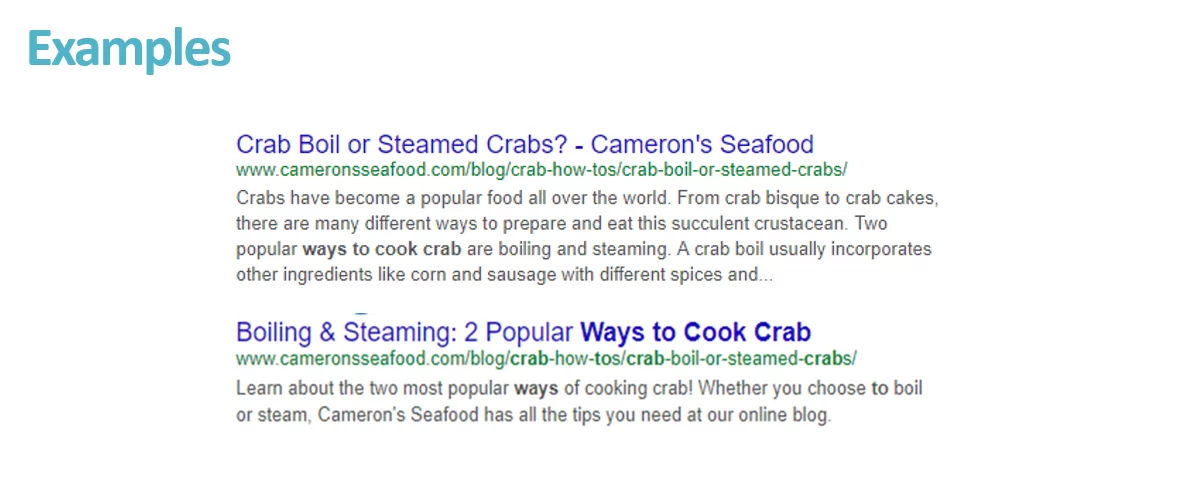The Google Subtopics Algorithm & SEO
Recently Google announced a range of new changes to its search program and to its satellite search features – with a slew of new algorithm changes to cap-off the end of 2020.
Their announcements include brand new concepts like “subtopics” for search results where a search query is very broad or too general. The new Google subtopics algorithm is intended to bring more variety to the search results page by providing results that are much more varied in what they mean for the original query. It’s another step toward Google’s long-stated goal of helping searchers find what they need – in this case for vague or general searchers where it’s not actually obvious what they want.
But with Google’s “subtopics” concepts comes a new responsibility for marketers and business to shift their digital marketing strategy by taking advantage of subtopics SEO optimization. This means that with a good on-page SEO strategy combined with keyword research, content optimization, and an understanding of what searchers are looking for, businesses can use subtopics SEO to increase their click-through-rate.
Most likely this will mean focusing on the existing best practices in SEO.
What are Google “Subtopics”?

Via Google
Google itself gave this new part of its search-engine algorithm its name.
What it means in a nutshell is that Google uses its algorithm to deliberately display results that focus on subtopics related to the search query (only for some searches). Their algorithm uses neural networks to understand subtopics around an interest/topic (or a search term) and then it delivers a greater diversity of content when users search for something broad.
Here’s the example they provide for a search on “home exercise equipment,” they can now understand relevant subtopics, such as budget equipment, premium picks, or small space ideas and then populate the SERP with results that try to cover all of these and more. The example they give is for a search like on exercise equipment where the SERP will then show results for “subtopics” like cheap home exercise, home exercise equipment for small spaces, high-quality, portable, etc.
With their algorithm’s ability to understand content much like the way a human would – including with a more widespread use of search-engine NLP – Google will be able to understand what pages are about far more specifically.
In their “Search On 2020” video accompanying the announcement of the Google subtopics algorithm update, Google’s Cathy Edwards described how the concept worked with the help of artificial intelligence in their search engine.
The subtopics let the engine “capture the particular nuance of what each page is really about.”
What do Google’s subtopics mean for SEO?
This will be part of the algorithm as early as next month. The key focus of “subtopics” is that Google wants to show more diverse updates on the SERP – especially for very broad or vague searches.
This update has the potential to make high-traffic head keywords a lot more competitive since now a wider range of results can appear. A lot of pages which might never have ranked for competitive keywords might have a way of appearing if they offer a focused look at a particular aspect of a greater subject – especially if Google thinks this might be relevant. But the subtopics algorithm might also help less competitive sites that have detailed and high-quality content.
There’s not much info on how the update works algorithmically, or what ranking “signals” it uses, but it makes sense that long-tailed and accurate keywords are more important than ever. There’s also a chance that content structure (with things like h-tags) might play a roll.
This concept will most likely make keyword research as an SEO strategy more important than ever – and it also means that matching the intent behind search queries, with targeted SEO keywords, as well as with on-page content will also be important. Businesses might find that if their content doesn’t effectively match with their long-tail keywords, then their SEO campaign might not get results.
Optimizing SEO for subtopics
The ranking signals and on-page elements that the search engine uses for subtopics isn’t well known. But subtopic SEO most likely means sticking with many of the already well-known best practices for search optimization.
Particularly well written, high-quality content. Likewise, setting up a site for on-page SEO means that businesses and brands will be best position for SEO in general and will likely be better set-up for getting into search results for sub-topics. The main reason why on-page SEO is important is because it’s the one form of search optimization that’s actually controllable.
This means many strategies familiar to businesses – like meta data optimization, keyword density, internal ATLs, content-creations, etc. – will be the best ways of doing Google subtopics SEO.
Keyword research and search intent
Being able to understand the idea of subtopics optimization begins with keyword research. Google’s subtopics algorithm is designed to push more “diversity” for broad queries – and this means that being able to get your brand/business in front of search will require knowing what subtopics your content best fits into as well as what your target audience is.
Keyword research is one of the most important steps to starting with SEO, and choosing the right keywords for your on-site content will determine the overall direction of your campaign and will have a very important effect on what keywords your website will rank for.
Google’s subtopics will largely affect what is displayed for broad, high-traffic queries where the searcher intent is very unclear.
With keyword research businesses can lay out what sort of search queries are important to them and determine where these keywords can best work within their content:
- Head keywords represent broad searches for shoppers and people who are just starting their journey through the search funnel. Google’s subtopics will have the greatest impact for searches like these.
- Long-tail keywords usually mean queries of 3-or-more words that are more descriptive, more precise and that suggest searchers that have a better idea of exactly what they want.

Because subtopics are meant to provide more diversity for broad keywords it’s likely that search engine results pages (SERPs) might see a greater blending between pages ranking for head/long-tail keywords. Keyword research will help improve click-through-rate (CTR) for long tail keywords that are subtopics.
For example: a broad topic might include something like “women’s long-sleeves” and subtopics may include long-tail KW variants like “women’s long-sleeve tops for skiing” or “knitted winter long sleeve shirts for women.”
Think about searcher intent
Search intent as a concept is more important than ever. Many businesses believe that aiming for high-traffic searches and getting more traffic is what they want – but the truth is that knowing the intent behind a search is far more important.
Search intent marketing on Google is the best way to not just get greater search traffic through better CTR – but to net visitors that are more likely to convert or make a purchase.
Search intent – also called keyword intent – represents the main goal of internet users when they enter a query into search engines like Google or Bing. As part of keyword research for SEO, thinking about the actual goal of the search is important to knowing how to get them where they need to go, providing the content they had in mind, and to getting them closer making the transaction they want. Google’s search quality evaluator guidelines layout how something like this can greatly improve the ability for your content to provide “needs met” for site users.
Web pages with high-quality, authoritative content can help users not just find what they intended, but also have their needs met completely with a product or service that fits the goal of their search query.
A good strategy is to think about common search practices and habits, and for each of your target SEO keywords ask yourself “what do my customers want when they make these searches?” “what sort of content would best help them?” From there you can improve your ability to optimize for subtopics SEO by curating content that’s targeted toward multiple concerns.
EAT content for subtopic SEO
The best way to approach Google subtopics optimization is likely to use the same best-practices outlined by Google for content. Their search quality evaluator guidelines have given marketers a good rule of thumb for what’s defined as good content via the concept of “EAT” (Expert, Authoritative, and Trustworthy).
Having high-quality content is absolutely one of the single most important things a business or website can do for their SEO. Content is one of the most heavily weighted ranking signals used by search engine algorithms. Writing content that is authoritative, expert, and trustworthy is the best bet for better SEO in general.
Businesses that want to perform better in search and to gain organic traffic should already be improving and optimizing their site’s content – but it’s most likely that if there is a way to do Google subtopics optimization that content will play a huge roll. And the best practice here is to follow Google’s existing instructions for SEO content.
Simply having content isn’t always enough, and low-quality, thin, duplicated, and scraped content can even hurt SEO rankings by threatening websites with a Google thin content penalty.
Their webmaster guidelines outline what they expect for quality content in search results:
- Make pages primarily for users, not for search engines.
- Don’t deceive your users.
- Avoid dishonest tricks intended to improve search engine rankings. A good rule of thumb is whether you’d feel comfortable explaining what you’ve done to a website that competes with you, or to a Google employee. Another useful test is to ask, “Does this help my users? Would I do this if search engines didn’t exist?”
- Think about what makes your website unique, valuable, or engaging. Make your website stand out from others in your field – this is where EAT really matters.
- Create a useful, information-rich site, and write pages that clearly and accurately describe your content.
- Think about the words users would type to find your pages, and make sure that your site actually includes those words within it.
- Try to use text instead of images to display important names, content, or links. If you must use images for textual content, use the alt attribute to include a few words of descriptive text.
These strategies are best practice for baseline SEO, but SEO for subtopics will mean detailed content that actually strikes at the hard of the page’s subject and its target keywords. Writing high-EAT content that is thorough and that focusing on meeting the needs of a wide range of searchers is the best way of potentially appearing for subtopics in the SERP.
Accurate and optimized meta data
Meta data information is another key ranking signal in SEO and on-page elements like meta title-tags are used by search engine algorithms to understand what a page is about and what its subject matter is.
For this reason optimizing title tags is one of the best ways of improving search rankings, and well-written meta descriptions are one of the best ways of boosting click-through-rate. These two strategies will also play a role in how Google’s new subtopics algorithm can affect website performance and how existing rankings might feed into search results with subtopics.
Best practices for the meta title tags means writing accurate, descriptive title-tags that include your target SEO keywords. Google and Bing will read the page’s meta title and use that to help determine keyword rankings – they also give suggestions for the best way of writing titles:
- Page titles should be descriptive and concise. Avoid vague descriptors that are too short and avoid writing title tags that are too long (longer than about 60 characters).
- Avoid keyword stuffing or writing title-tags that are clearly trying to rank aggressively for multiple keywords.
- Avoid repeated or boilerplate titles. Duplicate titles or titles that that target the same keywords can dilute SEO results and for subtopics, make it less clear which pages actually deserve subtopics results.
Optimizing title-tags for keywords also means thinking about the intent behind searches and shopper goals that might not be obvious.

The image above is a good example of a page title that addresses multiple topics, and where searches for “ways to cook crab” might mean different things to different searchers – for a broad search keyword like this a page might have a better chance for appearing as a subtopic result as an example for boiling crabs or steaming crabs.
Internal linking and anchor text
Another way that Google is able to determine the subject matter of pages includes inbound links. Both external and internal links tell search crawling bots which pages are related, and which keywords are related (by using the anchor-text attached to the link).

Link building and optimized anchor text are both some of the most important signals in SEO – but unfortunately also the most difficult to optimize, since there’s no way to build back-links manually. Artificial link building schemes can often hurt SEO or lead to a manual-action penalty, meaning businesses have to wait for them to grow naturally. But businesses and websites can optimize the internal links on their site to better channel important URL authority and to optimize keyword association.
Creating links and optimizing anchor text with target SEO keywords can help search engines understand your site’s structure as well as understand subtopics/alternate keyword associations. This means that the subject matter of anchor-text links (ATLs) can play a role in both latent-semantic indexing (LSI) but also potentially Google’s “subtopics” results.
Learn More
Contact us to learn about Google subtopics SEO strategies or to learn about growing your business online with on-page strategic SEO services.
Fill out the form below for more information or check out our client testimonials to see how our strategies have helped businesses succeed.
